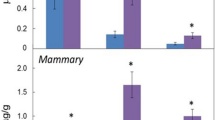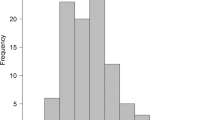Abstract
Tissue prostaglandin (PG) content and production by human breast cancers were measured in 24 human mammary carcinoma specimens. The 5 compounds studied were PGE1, PGE2, PGF2 alpha, 6-keto-PGF1 alpha, and TXB2. The tissue content of all 5 compounds was higher in neoplastic tissue in comparison with the paired noncancerous breast tissue. However, microsomal PG synthetase activity in vitro in noncancerous and neoplastic breast tissue was comparable. Increased thromboxane formation was associated with three clinical variables--tumour size, axillary lymph node metastases and distant metastasis. A lesion negative for either oestrogen or progesterone receptor content tended to produce more TXB2 but lower PGE2 and 6-keto-PGF1 alpha. Results obtained in this pilot study may provide clues as to what direction future larger studies could take in the search for reliable prognostic indicators for breast cancer.
This is a preview of subscription content, access via your institution
Access options
Subscribe to this journal
Receive 24 print issues and online access
$259.00 per year
only $10.79 per issue
Buy this article
- Purchase on Springer Link
- Instant access to full article PDF
Prices may be subject to local taxes which are calculated during checkout
Similar content being viewed by others
Rights and permissions
About this article
Cite this article
Karmali, R., Welt, S., Thaler, H. et al. Prostaglandins in breast cancer: Relationship to disease stage and hormone status. Br J Cancer 48, 689–696 (1983). https://doi.org/10.1038/bjc.1983.251
Issue Date:
DOI: https://doi.org/10.1038/bjc.1983.251
This article is cited by
-
Inhibiting breast cancer by targeting the thromboxane A2 pathway
npj Precision Oncology (2017)
-
Modulation of CXCR3 ligand secretion by prostaglandin E2 and cyclooxygenase inhibitors in human breast cancer
Breast Cancer Research (2012)
-
Hiding in plain view: the potential for commonly used drugs to reduce breast cancer mortality
Breast Cancer Research (2012)
-
NSAID use and survival after breast cancer diagnosis in post-menopausal women
Breast Cancer Research and Treatment (2007)
-
Inhibition of cyclooxygenase-2 decreases breast cancer cell motility, invasion and matrix metalloproteinase expression
BMC Cancer (2006)



